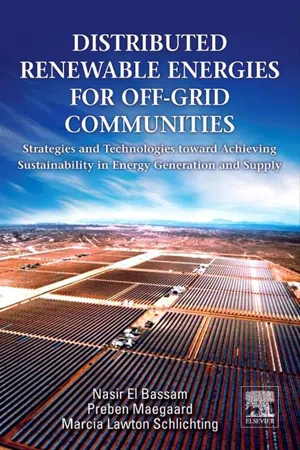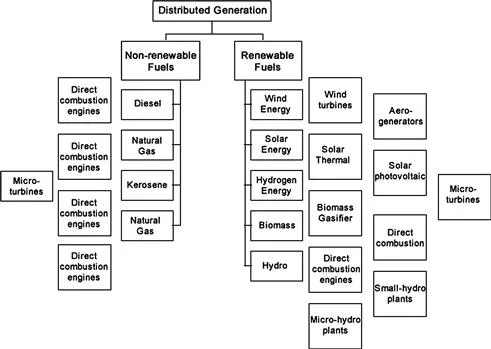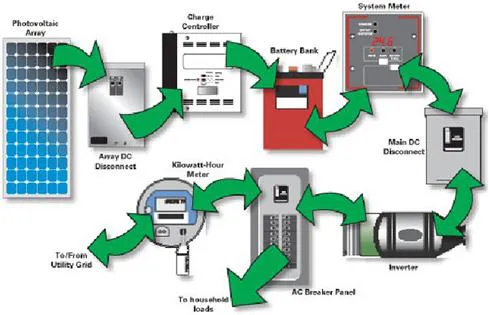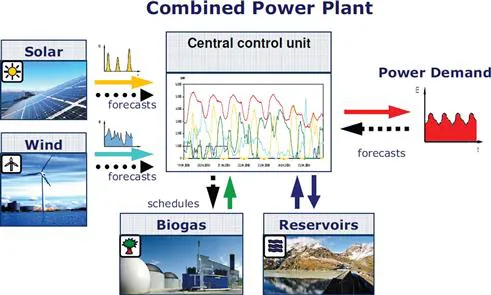![]()
Chapter One
Scope of the Book
Distribution means the delivery of electricity to the retail customer’s home or business through low-voltage distribution lines. Distributed generation is also called on-site generation, dispersed generation, embedded generation, or decentralized generation. Decentralized energy, or distributed energy, generates electricity, heat and fuels from many small energy sources. It reduces the amount of energy lost in transmitting electricity because the electricity is generated very near where it is used, perhaps even in the same building. This also reduces the size and number of power lines that must be constructed. Both electric demand reduction (energy conservation, load management, etc.) and supply are generated at or near where the power is used. A distributed generation system involves amounts of generation located on a utility’s distribution system for the purpose of meeting local (substation level) peak loads and/or displacing the need to build additional (or upgrade) local distribution lines.
1.1 Distributed Energy Generation
Distributed generation is also defined as installation and operation of small modular power-generating technologies that can be combined with energy management and storage systems. It is used to improve the operations of the electricity delivery systems at or near the end user. These systems may or may not be connected to the electric grid.
1.2 Distributed Energy Supply
Typical distributed power sources in a Feed-in Tariff (FIT) scheme have low maintenance, low pollution and high efficiencies. In the past, these traits required dedicated operating engineers and large complex plants to reduce pollution. However, modern embedded systems can provide these traits with automated operation and renewables, such as sunlight, wind and geothermal. This reduces the size of a profitable power plant.
In the future, when planning a new power and heating or transportation fuels system on a clean sheet of paper, there will not be any big fossil-fuel
Figure 1.1 Relevance of distributed generation.
(India Energy Portal, Distributed Generation). www.indiaenergyportal.org/subthemes.php?text=.
based power stations or big, high-voltage transmission lines. Each community in this new energy supply structure will have a variety of local supply technologies based on solar, wind, biomass and other locally available sources of energy.
Solar and wind will be the primary sources of supply. Biomass will be especially important for complementary power and heat when solar and wind is not sufficient. Balancing of fluctuating power from solar and wind is necessary; chemical and thermal storage solutions can also be applied. Such future supply systems can be of many sizes. The smallest will be for one family house or settlement and the biggest for a region or city.
As small-scale technologies can be mass produced and are therefore cheap, it may well prove preferable and most economical to divide up cities into many independent and autonomous decentralized systems. In this book we will call them off-grid, as there is no advantage to having international or interregional grid structures. Up to this point, off-grid supply has referred to unserved areas in developing countries without a national grid.
Distributed energy resource systems are small-scale power generation technologies (typically in the range of 3 kW to 10,000 kW) used to provide an alternative to or an enhancement of the traditional electric power system.
As the cost of fossil fuels increases and the cost of renewable energy technologies declines and government support increases, investors, utilities, and governments are exploring ways to implement or invest in distributed renewable energy programs, projects and companies.
1.3 Community Power
Community is a term that has different meanings for different people. In this book a community is defined as a social group of any size whose members live in a specific place. The term thus relates to geographical proximity, or “communities of locality” (Walker 2008), such as a neighborhood, town, district or city. This book focuses on distributed energy that is generated and distributed to consumers within a geographic locality. Distributed energy generation can be a continuum of energy generation from a household and multiple-buildings scale to a larger-community scale. Some energy may be fed back into the electricity grid, but ideally at least some of the total energy generated is distributed and consumed locally.
The book profiles the special topic of Community Power – Citizens’ Power, referring to the development and ownership of renewable energy projects by local citizens and communities, including farmers and landowners, cooperatives, municipalities, local and regional developers and utilities.
1.4 Off-Grid Systems
Off-grid systems provide an independently regulated power supply that has at least the same reliability and quality as a public power grid.
The term off-grid refers to not being connected to a grid, mainly used in terms of not being connected to the main or national transmission grid in electricity. Off-grid electrification is an approach to access electricity used in countries and areas with little access to electricity, due to scattered or distant population. It can be any kind of electricity generation. Electrical power can be generated on-site with renewable energy sources such as solar, wind or geothermal; or with a generator and adequate fuel reserves.
It can also connect to local and national grids to substitute for energy supply generated by nuclear or other non-renewable fuel sources, which is called green electricity in some industrialized countries.
Figure 1.2a, b Stand-alone off-grid systems.
http://www.wholesalesolar.com/products.folder/systems-folder/OFFGRID.
Figure 1.3 Off-grid system which can also be connected to the grid.
Reprinted with permission. ©2012 Home Power Inc., www.homepower.com.
Figure 1.4 Combined power plant.
http://www.blog.thesietch.org/2007/12/30/germany-going-100-renewable-or-yet-another-reason-why-america-is-falling-behind/. (Accessed March 23, 2010). (See color plate 1.)
This book illustrates the future of off-grid power supply, as there is no advantage to having international and/or interregional grid structures. So far, off-grid supply has generally referred to communities in developing countries without a national grid. Due to the decentralized character of the renewable energies, the future rationale will be to apply off-grid technologies to all types of communities, urban and rural, in fossil-fuel served areas in the industrialized countries, and for unserved regions in developing countries as well. What thus far has been the exception may, due to the transition to decentralized energy forms, change to become mainstream.
Similar fundamental changes have often appeared when considering the long historical perspective. Facing the end of the fossil-fuel age and the enormous risks of the ongoing climate change, it is time to prepare for the exit of the fossil-fuel era. And there are no technological barriers—this is the important message of the book.
References
1. Gangwar R. Building community resilience towards climate change adaptation through awareness and education. Paper presented at the seminar Energy and Climate in Cold Regions of Asia 2009;21–24 April, 2009, available at http://india.geres.eu/docs/Seminar_proceedings/3-Climate_Change_Impacts_and_Adaptation/Building%20Community%20Resilience%20towards%20Climate%20Change%20Adaptation%20through%20Awareness%20&%20Education.pdf; 2009.
2. Renewable Communities. Renewable communities: Moving towards community resiliency 2008; [online] available at http://renewablecommunities.wordpress.com; 2008.
![]()
Chapter Two
Restructuring Future Energy Generation and Supply
2.1 Basic Challenges
By 2050, humanity will need two to three earths to cover its consumption of resources, if we continue to manage our resources as business as usual.
The global energy system currently relies mainly on hydrocarbons such as oil, gas and coal, which together provide nearly 80 percent of energy resources. Traditional biomass—such as wood and dung—accounts for 11 percent and nuclear for 6 percent, while all renewable sources combined contribute just 3 percent. Energy resources, with the exception of nuclear, are ultimately derived from the sun. Non-renewable resourc...




